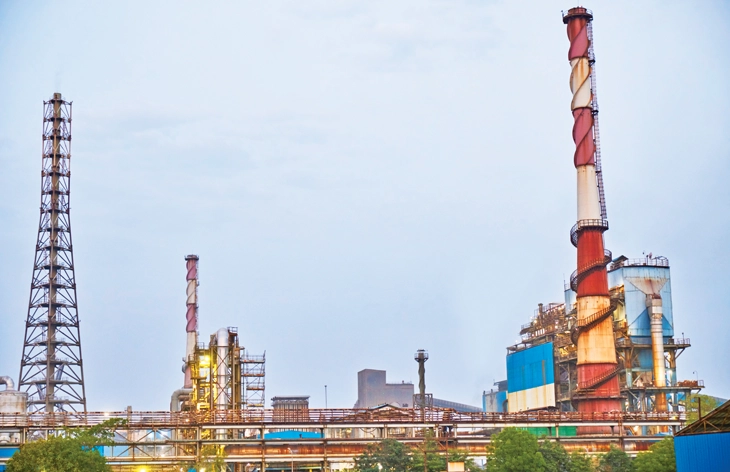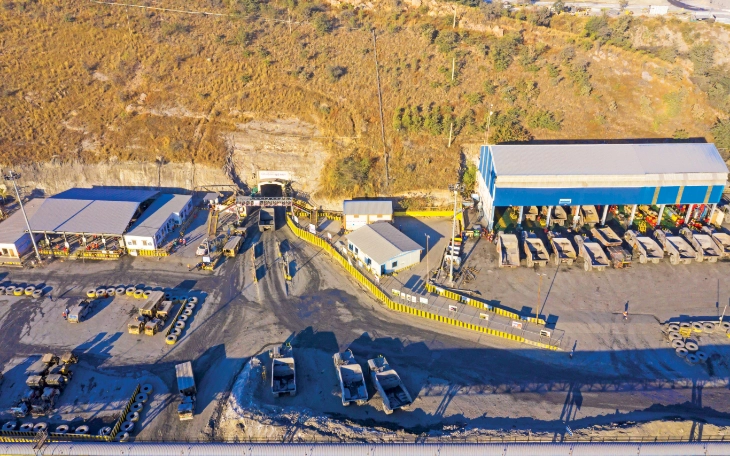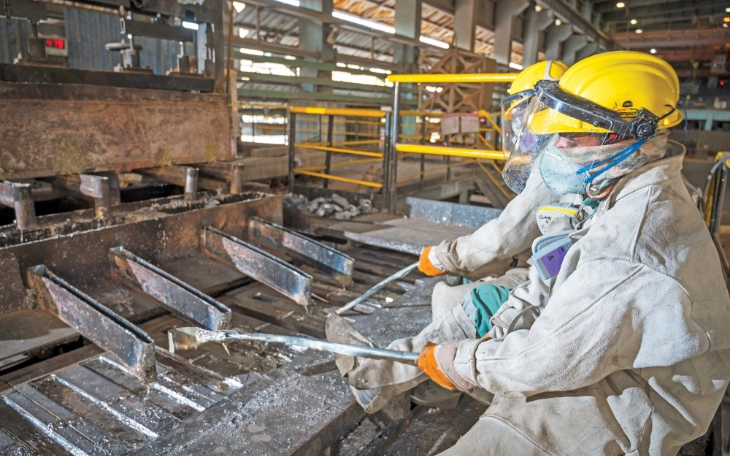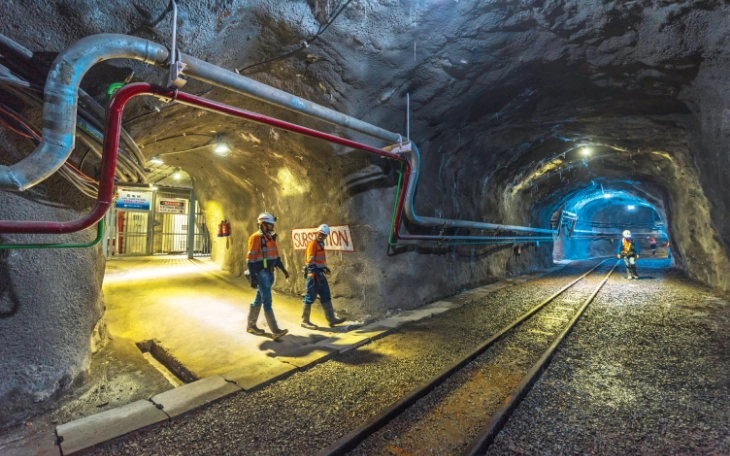Operational Review

Zinc India stands as the world’s largest integrated zinc producer and maintains a strong position among the lowest-cost producers globally, consistently operating in the first decile of the global cost curve. This leadership is underpinned by efficient resource management, high-grade ore, and a relentless focus on automation and operational excellence. The business continues to enhance plant availability and recovery rates, driven by process optimisation and continuous improvement.
In FY 2024-25, Hindustan Zinc achieved its highest-ever mined metal production at 1,095 kt, up from 1,079 kt in the previous year, driven by improved grades, mill recovery, and operational efficiency. Ore production stood at 16.3 million tonnes, marginally down 1% Y-o-Y due to lower output at Rajpura Dariba, Sindesar Khurd, and Rampura Agucha mines. Refined metal production reached a record 1,052 kt, up 2% Y-o-Y, supported by consistent plant availability and strategic operational focus. This included 827 kt of refined zinc (up 1%) and 225 kt of refined lead (up 4%).
In CY 2024, zinc emerged as the best-performing metal on the London Metal Exchange, driven by macroeconomic factors that led to mine closures and delayed restarts, tightening the concentrate market significantly. This supply deficit pushed spot treatment charges to historic lows in September, impacting smelter profitability and triggering global production cuts, with smelter output falling 4% to 13.2 million tonnes. Despite weak demand in several regions, interest rate cuts in the US and Europe and improved investor sentiment drove a 1.7% rise in global zinc consumption to 13.6 million tonnes. Consequently, zinc prices averaged US$ 2,875/t in FY 2024-25, up 16% Y-o-Y.
Silver prices also rallied, buoyed by expectations of US interest rate cuts and heightened geopolitical tensions in the Middle East, peaking at a decade high of US$ 34.51/oz. For FY 2024-25, silver averaged US$ 30.39/oz, marking a 29% increase Y-o-Y. With limited new supply and rising industrial demand, market sentiment for silver remains strongly bullish.
The global refined zinc demand is showing signs of recovery, with significant momentum expected from Asian economies. This is being supported by a rebound in global manufacturing activity and increased investments by Chinese authorities. On the supply side, continued delays in major mining projects could sustain the tightness in the concentrate market, affecting refined metal output. This may be further impacted by smelter suspensions linked to profitability and environmental constraints across key producing regions.
During CY 2024, LME and SHFE warehouse stocks rose 10% (from 243 kt to 268 kt), but the market remained in a strong deficit due to constrained supply. CY 2025 began with LME stocks falling to 180 kt and SHFE stocks dropping to a record low of 20 kt in January. The market is expected to remain in deficit through CY 2025, though successful project commissioning may offer some relief. On the demand side, India has outperformed global trends. The HSBC India Manufacturing PMI rose to 56.4 in December 2024 from 54.9 a year earlier, signalling continued expansion, while the JP Morgan Global Manufacturing PMI increased slightly from 49.0 to 49.6, remaining below the neutral 50 mark. According to the World Steel Association, India’s crude steel production rose 6.3% to 149.6 million tonnes in CY 2024, even as global output declined marginally. With the Indian economy projected to grow by 6.5% in FY 2024-25, it is expected to lead global steel demand growth, fuelled by infrastructure and construction activity, positioning India as the third‑largest zinc consumer globally.
For FY 2024-25, Zinc cost of production (COP) excluding royalty stood at US$ 1,052 per tonne, down 6% Y-o-Y (4% lower in INR terms), driven by record production, improved mined metal grades, higher domestic coal and renewable energy usage, and better acid realisations. This was further supported by softer coal and input commodity prices, along with Y-o-Y operational efficiencies. The Company exited the year with a Zinc COP of US$ 994 per tonne, the lowest in four years, reflecting strong business fundamentals, continuous cost-saving initiatives, robust operational performance, and increased automation.

Hindustan Zinc’s exploration strategy aims to upgrade resources to reserves and replace every tonne of mined metal to sustain production for over 25 years. The Company continues to pursue an aggressive exploration programme across existing licence areas, supported by technology and innovation. Several new targets have been identified within existing leases, as deposits remain open at depth. Surface drilling has been intensified across sites to support resource addition and reserve conversion.
As in previous years, Mineral Resources are reported exclusively from Ore Reserves, with estimates independently audited by SRK (UK). As of FY 2024-25, Ore Reserves stood at 189.1 million tonnes (net of 16.3 million tonnes depleted during the year), while exclusive Mineral Resources totalled 264.1 million tonnes. Contained metal in the Ore Reserves includes 10.3 million tonnes of zinc, 2.8 million tonnes of lead, and 304.8 million ounces of silver. Mineral Resources contain 11.5 million tonnes of zinc, 5.0 million tonnes of lead, and 503.5 million ounces of silver. These reserves underpin production for more than 25 years at current mining rates.
Beyond its zinc-lead-silver assets in Rajasthan, the Company is expanding its mineral portfolio by participating in auctions for strategic and critical minerals. A dedicated subsidiary, Hindmetal Exploration Services Pvt Limited (HESPL), has been established as a NABET-accredited Category-A exploration agency. HESPL is currently managing 10 exploration projects across seven Indian states, covering commodities such as gold, copper, nickel, PGE, tungsten, cobalt, manganese, vanadium, graphite, and diamond. In FY 2024-25, the Company secured two composite licences for gold in Rajasthan and tungsten and associated minerals in Andhra Pradesh.
Revenue from operations for FY 2024-25 was ₹ 32,903 crore, an 18% increase Y-o-Y, driven by record metal production, higher zinc and silver prices, a stronger dollar, and strategic hedging gains. EBITDA for the year reached ₹ 17,365 crore, up 28% Y-o-Y, reflecting record metal volumes, lower production costs, higher zinc and silver prices, and a stronger dollar. This was partly offset by lower silver volumes and reduced lead prices.
Rooted in sustainability and ESG excellence, Hindustan Zinc has consistently demonstrated its critical role as the forerunner in clean energy transition metals. We have been recognised as global ESG leader in S&P Global Corporate Assessment 2024 with us being ranked 1st globally in metals and mining sector for the second consecutive year. With an improvement in overall score to 86, Hindustan Zinc also got featured in Sustainability Yearbook 2024 amongst the top 1% most sustainable organisations globally for the second consecutive year.
Hindustan Zinc is committed towards environmental conservation. We are committed to reducing our carbon footprint, minimising air emissions, managing water and waste efficiently, and fostering biodiversity. These actions are integral to our broader objective of responsible and sustainable operations.
Our decarbonisation journey has been validated by the Science Based Targets initiative (SBTi), which approved our near-term and net-zero goals aligned with the 1.5°C trajectory. We aim to reduce absolute Scope 1 and 2 GHG emissions by 50%, and Scope 3 emissions by 25% by FY 2029-30, from a FY 2019-20 baseline, with a vision to achieve net-zero emissions across our value chain by FY 2049-50. Additionally, we are the only Indian company shortlisted for setting Science Based Targets for Nature (SBTN), through which we will establish specific targets related to freshwater and land use.
We also became the first company in India’s metals and mining sector to publish a Climate Action Report aligned with the International Financial Reporting Standards (IFRS) S2 – Climate-related Disclosures framework. As part of our clean energy transition, we signed incremental power delivery agreements to enhance renewable energy capacity from 450 MW to 530 MW. In FY 2024-25, approximately 13% of our total power requirement was sourced from renewables. This initiative is expected to significantly reduce our GHG emissions by 3.5 MtCO₂e annually by 2028.

Our investment in clean energy has further enabled us to launch Asia’s first low-carbon zinc product, EcoZen, with a carbon footprint of less than 1 tCO2#e per tonne-approximately 75% lower than the global average.
To further reduce Scope 3 emissions, we introduced battery-electric vehicles (BEVs) in underground mining operations at Sindesar Khurd Mine, deployed electric trucks for inter-unit logistics, established EV charging stations, and integrated LNG-powered trucks for transportation. These actions have already contributed to measurable emission reductions.
In alignment with our water stewardship goals, a 4,000 KLD zero liquid discharge (ZLD) plant at Rampura Agucha Mine is nearing commissioning, which will reduce freshwater dependency and support our vision of becoming five times water positive by 2025. Additionally, the dry tailing plant at Rajpura Dariba Mine became operational in September 2024, enhancing water recovery from tailings. This makes it our second operational dry tailings facility after Zawar Mines.
We partnered with the International Union for Conservation of Nature (IUCN) over a three-year period to develop Biodiversity Management Plans (BMPs) across all locations, excluding Pantnagar Metal Plant. These efforts contribute to our goal of achieving no net loss of biodiversity against a 2020 baseline.
As part of our ongoing waste reduction efforts, the commissioning of the first fuming furnace at Chanderiya Lead Zinc Smelter (CLZS) has improved metal recovery while reducing jarosite waste generation. We also secured an Indian patent for a novel method of manufacturing paver blocks and bricks from industrial waste, demonstrating innovation in circularity.
In support of energy storage innovation, we partnered with IIT Madras and JNCASR to develop sustainable battery solutions. A prototype 1 kWh rechargeable Zinc-Air battery is under development, offering a cost-effective and durable alternative to conventional lithium-ion batteries.
We also launched a training initiative titled “Wednesday for Transition” to enhance ESG awareness among our suppliers. The sessions focussed on key topics such as biodiversity, safety, and materiality, reinforcing our sustainability ecosystem.

Safety and well-being of our employees and business partners are of paramount importance. We remain steadfast in our commitment to creating a secure working environment, anchored in our 'Zero Harm' philosophy. Despite our unwavering focus on safety, we deeply regret the loss of three business partner colleagues and one employee in work-related incidents during the year. Each incident was thoroughly investigated through root cause analysis, and learnings were systematically integrated into our safety protocols to drive continuous improvement.
In alignment with Vedanta’s vision of zero fatalities, we launched the Vihaan–Critical Risk Management (CRM) programme, designed to proactively identify high-risk activities and implement critical controls to prevent fatal incidents. To further reinforce operational safety, we adopted the Infrastructure Inframatrix framework, which systematically assesses, monitors and controls infrastructure associated with top operational risks. This initiative is complemented by the efforts of the Structural Integrity Management Committee, which prioritises structural risks based on criticality ranking by evaluating the condition and load of key infrastructure assets.
The Suraksha Kavach initiative, which addresses high-risk tasks, was expanded to include 13 smelting operations, in addition to the 25 mining activities already covered. We also continue to build a safety-focussed workforce by facilitating both internal and external training programmes, including nationally and internationally recognised courses aimed at upgrading the technical and behavioural skills of our employees and business partners.
Our commitment to emergency preparedness is reflected in the maintenance of world-class rescue facilities equipped with advanced technology and trained personnel. Notably, in FY 2024-25, 23 women employees were trained in work-at-height and confined space rescue operations, underscoring our emphasis on inclusivity and readiness in emergency response.
Occupational health remains a key focus area. Regular medical examinations and industrial hygiene assessments are carried out to manage exposure to hazardous substances, noise, and air quality risks. In FY 2024‑25, over 1,300 industrial hygiene sample assessments were conducted to monitor and enhance workplace health standards.
Through strategic safety interventions, leadership accountability, and adoption of best-in-class technologies, Hindustan Zinc continues to advance industry benchmarks in operational health and safety.